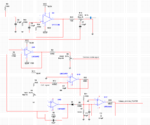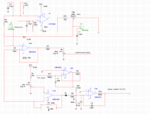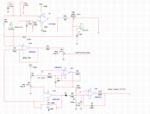Hasan2017
Member level 4

Hello there,
This post might be a fun for learning, some of you might laugh to see it once!
Trying to control old TCA785, a phase control IC, https://images.100y.com.tw/pdf_file/TCA785P.pdf.
But before that, take a look my circuit in this attachment ….

1. Lets say 0-10 VDC signal in increments of 1 volt or a 0-20 mA signal in increments of 1 mA has given to inverting input of
U1D,pin 13, CVC signal.
2. At U1B, pin 5, reference voltage has applied, lets say 3-5 volt dc, its frequency dependent RC parallel feedback resistance contributing gain curve.
3. All op-amp has negative feedback.
4. Common mode signal is generated from external IC.
5. U1A looks like buffer amplifier.
6. U2 op07 looks like active low pass filter.
7. U1C and U1D positive pins are grounded!!
8. Not sure pot R6 and R16 are wrongly connected ?
Discuss and advice whatever you like to suggest for further development. i.e stable gain, linearity, impedance, noise!
Raise your hand where I am doing wrong
Calculation, signal analysis is necessary.
This post might be a fun for learning, some of you might laugh to see it once!
Trying to control old TCA785, a phase control IC, https://images.100y.com.tw/pdf_file/TCA785P.pdf.
But before that, take a look my circuit in this attachment ….

1. Lets say 0-10 VDC signal in increments of 1 volt or a 0-20 mA signal in increments of 1 mA has given to inverting input of
U1D,pin 13, CVC signal.
2. At U1B, pin 5, reference voltage has applied, lets say 3-5 volt dc, its frequency dependent RC parallel feedback resistance contributing gain curve.
3. All op-amp has negative feedback.
4. Common mode signal is generated from external IC.
5. U1A looks like buffer amplifier.
6. U2 op07 looks like active low pass filter.
7. U1C and U1D positive pins are grounded!!
8. Not sure pot R6 and R16 are wrongly connected ?
Discuss and advice whatever you like to suggest for further development. i.e stable gain, linearity, impedance, noise!
Raise your hand where I am doing wrong
Calculation, signal analysis is necessary.



